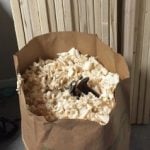On Planes
Welcome! / Forums / General Woodworking Discussions / Tools and Tool Maintenance/Restoration / On Planes
Tagged: planes
- This topic has 28 replies, 13 voices, and was last updated 6 years, 10 months ago by
nevynxxx.
-
AuthorPosts
-
Paul talks often about how you only *need* an #4 plane, and it will do everything you want. Chris Schwarz of Lost Arts Press says very similar things about the #5 in his “Anarchist’s Tool Chest” book.
Now, I’m in the extremely fortunate position to have inherited a couple of boxes of tools, I currently have around:
- Bench Plane Stanley 4
- Bench Plane Bedrock 605
- Bench Plane Record 5 1/2
- Bench Plane Stanley 6
- Bench Plane Stanley 7
- Bench Plane Stanley 10
- Shoulder Plane Stanley 78
- Circular Plane Record 020c
- Scraper Plane Stanley 80
- Small Hand Router Stanley 271
- Hand Router Stanley 71
Ignoring the weird and wonderful ones (that circular plane looks like a right faff to set up 😉 )
So, I get that the longer/wider ones are going to be “better” for longer, wider pieces of wood…. But does it all go off feel, or are there rules about which you’d pick when?

I don’t know. For me, if I’m doing a lot of extensive planing, it can become quite exhausting (like tennis elbow) to do it with a larger plane so a nice, light #4 can work well (though if I do anything long enough it will take a toll on me physically). I think the #4 is a good compromise since you can make relatively fine-tuned shavings that might be a bit more tricky with a #5. That said, just anecdotally I think I’ve seen enough people who seem comfortable using the jack plane as the all-purpose plane. And since each plane kind of has it’s own personality, I think there is a lot of personal preference involved–find what works best for you and what you enjoy using the most.
To answer the OPs question as best an ignorant beginner can, I haven’t found any rules. Well, maybe just the one rule to which the OP already alluded: It is a fact that a long plane cannot get into a valley which is shorter than the plane’s sole as measured along the same axis as the valley. If we accept that there is just that one rule, there might be guidelines, and I have found those guidelines in this video to be very straightforward to follow, and that they produce excellent results with much reduced effort from my previous approach:
Oddly, I’m going in the opposite direction as the above posters. I actually got an old #8 which I made into my scrub plane, and my good #7 has always been for flattening.
I’m already over 100 kilos; the difference to me between the weight of a #4 and a #7 or #8 simply isn’t significant, so might as well get as much length as possible, to get as flat as possible. This is the first project on which I used my big scrub plane, but so far, so good.
For getting into small areas, I do agree a smaller plane is best, so I use my tiny little #4 1/2. 🙂
As for Paul saying a #4 is all you need…I think there’s a bit of misunderstanding about Paul’s message…although perhaps I’m the one with the misunderstanding. It seems to me he is not saying “Use a #4 for everything, it’s better than every plane in every situation”. I think he is saying, “If you’re just starting off in woodworking, you don’t need to spend a lot of money or acquire a pile of planes, you can produce good results with just a #4 as your first plane.” IMHO, that doesn’t mean it’s unreasonable to ever acquire additional planes; Paul himself obviously has a healthy collection. It’s just that he’s trying to teach a way whereby woodworking is made accessible to the widest audience possible, so he demonstrates what can be done with a simple set of tools, rather than putting forth an intimidating array of demands on your pocketbook and available workspace, such as we’ve seen in the past with shows such as, e.g. Norm Abrams…”and now we’ll go over to my 10 hp molding machine, hook up the automatic stock feeder, and go warm up the 36″ thickness sander…”
Given that the OP has the good fortune of inheriting a nice variety of planes, I’d suggest watching the Chris Schwarz video a few times, and trying his approach. Traversing the grain with a proper scrub plane makes hogging off relatively huge amounts of wood a simple, quick and amazingly non-physically demanding task, which leads to making the entire process of preparing your stock a much easier and quicker process.
Schwarz did a DVD on this and it is covered in some older texts and to a degree Paul covers the same ground. The gist of it all comes down to this simple rule of thumb: Coarse, Medium, Fine. The longer bigger planes are generally coarser tools (scrub plane despite smaller size is about the coarsest), then you refine the work with a medium tool, this would be a #5 maybe a #6 if you started with the #10. Finally after you are near desired stock size and flatness you shift to the a smoother typically a #4 but on finer work could a #3 or even #2.
https://lostartpress.com/collections/dvds/products/coarse-medium-fine is the DVD in question.

You have to take into account that Paul almost always use machined stock. For that kind of wood it’s true that a #4 is all you need.
My experience is that if you have to prepare your wood from rough stock a #5 is a must have, but unless you’re making pieces longer than 5′ you don’t need anything longer than that.
And surely you don’t need a 500$ n°7 to plane flat a 30″ panel.Anyway I’ve made a lot of pieces from rough stock and my current array of planes is:
No4 transformed to scrub
No5 with a flat iron as flattening plane
No4 as an smoothing plane
No4 1/2 super finely set surface finisherSometimes I put the curved iron of the scrub plane on the #5 if the piece of wood is long
Regards
Mateo
@43gradosnorteKeep in mind that how you profile the blade is just as important as the plane. If I had that set of planes, I’d probably:
1. Sharpen the #4 with a very slight camber or with Paul’s dubbed corners, set the mouth tight. This makes it optimized as a smoother and still able to do all the things Paul shows. The camber or dubbed corners means you can plane wide boards without leaving track marks.
2. I’d set up the 5 1/2 in the same way for the same purpose, but it will also be nice for leveling the tops of carcases and drawer boxes since it is a little longer without being unwieldy. It’s nice and wide, so you may find it in use lots of times instead of the #4.
3. I like long planes on a shooting board. Easier to grip. I’d sharpen the #7 dead straight across, no camber, but put a square on it, sole to cheeks, and if the #6 is more square, then I’d use it instead. This is for shooting board or straightening long edges. But you can use the #4 or the #5 1/2 instead.
4. Get $20 and buy a junk plane to turn into a scrub.
The rest are kind of obvious, specialty planes. Since you’ll never, ever want it, I’d put the #10 and 020c in a box and mail it to me. : – ). Or, tune the #10 up and you might find it helpful for tuning tenons. Paul showed us a trick of paring next to the shoulder with a chisel to get the portion that a regular #4 won’t reach, but then you grab the #4 for the rest. Does that make sense? (A regular plane can’t cut all the way to the edge.) I used a block rabbet plane to clean up the posts on cabriole legs, to level them with the apron yet still work all the way down to the shoulder of the curved part of the leg. I’ve never tried a #10 for this (or anything), but suspect it would be excellent. A shoulder plane plus a #4 or some careful paring plus a #4 would also do it. But, you have the #10, so I mention it. Just don’t use the #10 on your shooting board or, if you do, send us pictures so we can laugh.
If you have some spare blades, put a back bevel on one to fake a York pitch, but if you don’t have one, don’t worry about until you need it. I’d prep the planes in the order I listed. Get the #4 going first and start building whatever you want with it. In your spare time, tune up the others. I guess if you’re prepping by hand, the scrub plane might be second.
That’s an awesome set of planes. Do up the #4 and get building. As you build, it will all become clearer.
 19 June 2017 at 4:22 pm #313051
19 June 2017 at 4:22 pm #313051Thanks for posting that video. I will attempt this method. It looks very effective and relatively simple. Being that I am terribly out of shape this may keep me from collapsing after just one board! =o)
In the video, is it me or is that face clearly not flat when he planes the first edge ??
Also, when he marks the reference face, track marks are clearly visible. How can the face be perfectly flat if you can see track lines !? And it follows that the edge will not be at a perfect 90° all along the face.Actually this is quite good because having started woodworking just a few months ago, I have been wondering how flat should flat be ? How square should square be ? So when I am preparing a board as in this video and I take a look using a flat edge, if any – and I really mean any – light shows between the board and the straight edge, then I will continue working on it. Same goes with squaring up the edges, etc. Am I being a little (or way too much) too finicky. Should I allow some sort of tolerance ?
He says a few times that he’s leaving it as he would for internal, or back facing bits. That for your nice looking bits you’d go over with a smoother to remove those tracks etc.
It’s like the fact that if you scale a billiard ball up to the size of the earth, the earth would be smoother…. it’s all about scale, or in our case if you mean flat, or smooth…..
-
AuthorPosts
- You must be logged in to reply to this topic.
